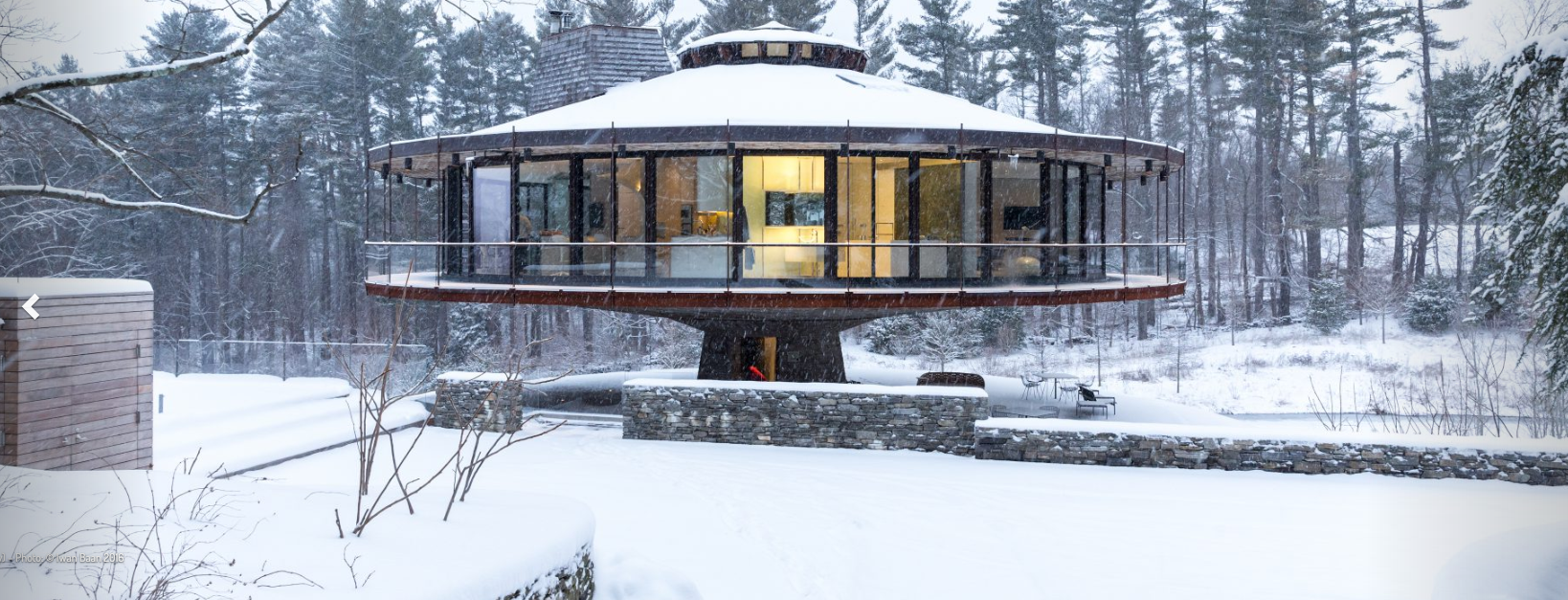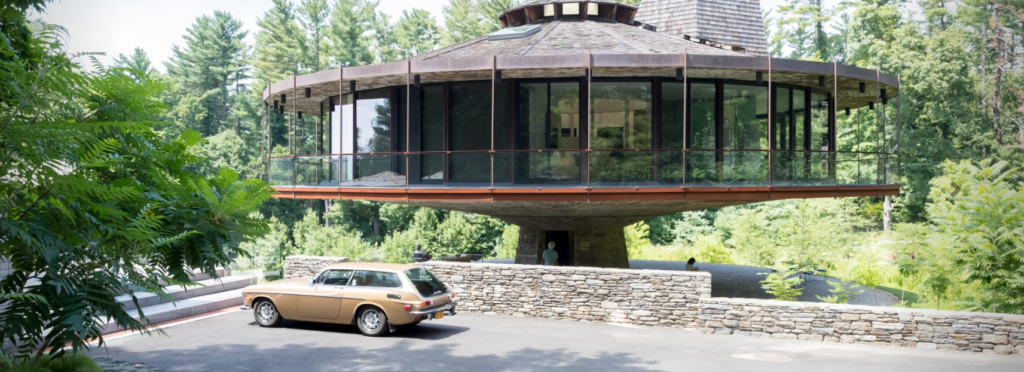
Image courtesy of roundhousewilton.com
A house with several names, the Richard Foster House in Wilton, CT is also known as the Spaceship House, the Round House, and the Circambulant House. How does one come up with such an interesting design? The initial inspiration for the home came to Richard Foster when he found “a perfect amphitheater,” as he called it, in the landscape while driving on Olmstead Hill Road.
After discovering the green dip in the landscaping, Foster worked through five different design ideas for the home before deciding on the final product. It took two years for Foster and his team of craftsmen and contractors to finish construction on the home. Throughout the planning and building, Foster’s main goal was to create an environment where one could view the beautiful landscape from any room in the house.
But this meant going farther than just adding large windows throughout. Foster was inspired to add a 360-degree rotation feature to the home, enabling his family to see not only the view directly outside the window, but to see the view surrounding the entire home.
Construction on the home began in 1967 and it only took a year for the home to be featured in Architectural Record. In 1993, Richard Foster wrote “The Circambulant House, 25 years later” as a reflection of his time raising a family and living in the home. Within it, he recounts his connection with nature, the changing seasons, the need for air conditioning, or not, and the joy of entertaining guests for dinners.
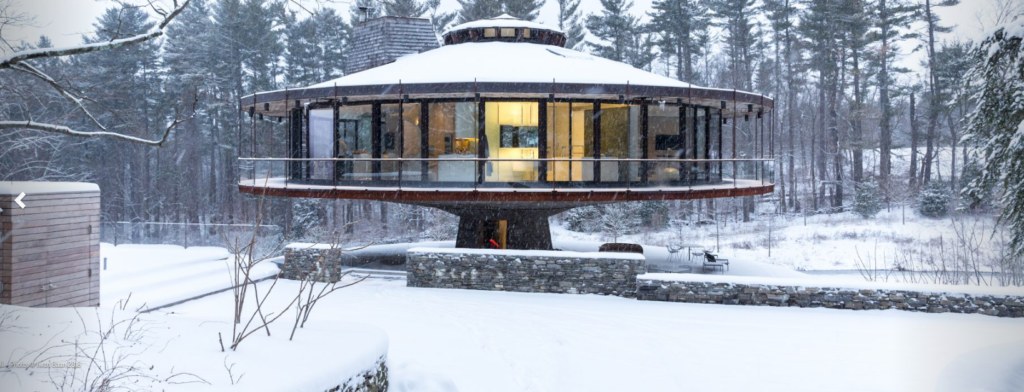
Image courtesy of roundhousewilton.com
The final 2,997 square-foot home was built with local Connecticut steel and stone from the Dolomites, and designed with German engineering. By the time of completion, Foster believed the design offered the perfect complement to the landscape and amazing views for those inside.
It Really Does Rotate
The Spaceship House isn’t just designed to provide beautiful views from every room through large windows and a curved exterior. It actually rotates around a fixed spiral concrete stair with a three-ton ball bearing assembly. The upper main portion of the home includes an umbrella-shaped steel structural system and concealed trolleys and troughs for plumbing, water, and electrical connections to pivot as the home rotates. A testament to Foster’s design and the work of his team, throughout the 35 years the Foster’s lived in the home, very little maintenance was required for the rotation mechanism.
While the era was famous for rotating restaurants, the Richard Foster House didn’t use the same system as revolving restaurants were using. In fact, the home didn’t have to rotate consistently throughout the day. In an article from the Daily Town Crier in 1968, Foster is quoted saying “We press the buttons when we want to change the view; some-times twice a day, sometimes four times a day, it depends. We don’t just take rides.”
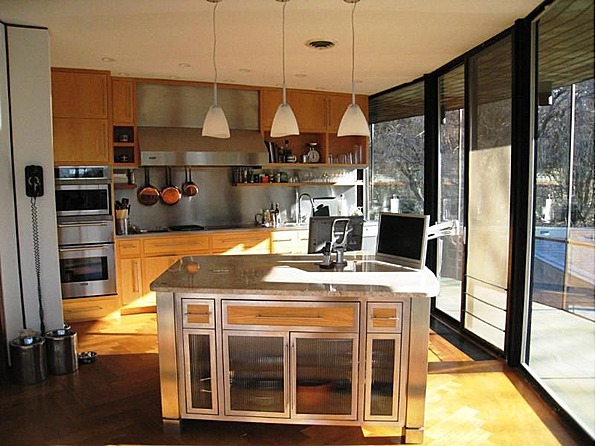
Image courtesy of Take Sunset Real Estate
Speaking of food, the kitchen had a few special features designed to make cooking simpler for the family. One of the cabinets was originally designed to rotate a full 360 degrees, while another could rotate 180 degrees. The cooling unit in the kitchen was also moveable and able to be placed anywhere it was needed at the time. Today, the kitchen has been remodeled and many of the original features have been removed in favor of more modern and up-to-date technology.
It was designed with plenty of complexity, but the controls within the house were rather simple. A push of a button could make the 1.5 horsepower motor turn on and move the home up to five feet per minute, meaning at top speed the home would fully rotate in 48 minutes. At the lowest speed, the same rotation would take four hours. For those not used to the movement, it feels much like walking across the deck of a ship out to sea. When asked how the family dog reacts to the movement, Mrs. Foster replied “Oh. Beau loves it. The house moves slowly, evenly. You hardly notice it’s moving at all. If the house is turning, the dog likes to sit out on the deck. It’s cool there.”
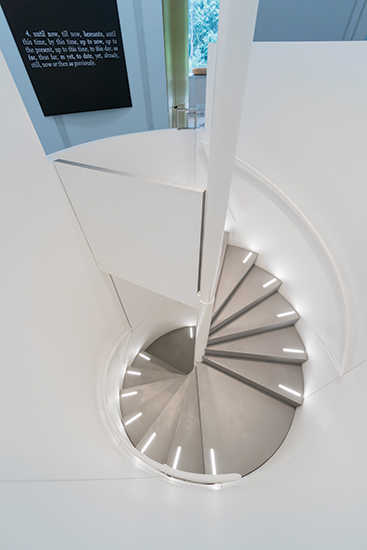
Image courtesy of Architectural Record
While the home has the ability to rotate and provides amazing views from any room, the center of the home doesn’t really see much sunlight. In fact, it has been referred to as melancholy. Still, with the most recent 2012 renovation breathing new life into the home, the staircase is a bright white, offsetting the lack of natural light.
About the Round, Spaceship, Foster House
The home was originally built with just under 3,000 square feet of living space on a 3.83-acre lot. It is 72-feet in diameter and offers a more than 4,000 square foot circular courtyard. The home also features 30 floor-to-ceiling window bays, half of which are sliding doors.
Each of the 10 rooms has access to the six-foot cantilevered deck surrounding the home. This deck is protected by what was originally an iron handrail but has since been upgraded to glass to clear sight lines from the home. It wasn’t exactly the safest spot for youngsters but did provide those on the deck with a serious sense of freedom. Plus, the Foster’s dog, Beau, loved to spend time on the deck as it slowly rotated, giving him a continuous view of nature and wild animals.
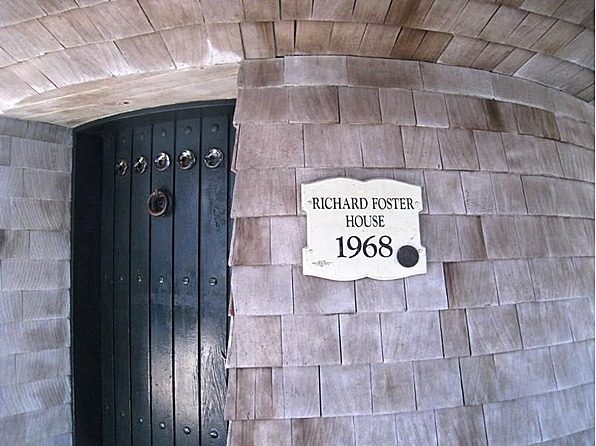
Image courtesy of Take Sunset Real Estate
There is only one way in and out of the home, through a door found within the ten-foot column at the center of the home. When originally built, the column’s design was certainly a feat of engineering. Still to this day, it is arguably one of the most unique homes ever created.
Foster died in 2002 at which point the home was sold to buyers outside the Foster family. In 2010 the home went on the market again. Then in 2012, the home was renovated. The landscape was redesigned in 2014. For the second time, the home was featured in Architectural Record in 2017 with a profile on the renovation done in 2012.
Listed For Sale in 2010
In 2010, the Round House or Foster House in Wilton, Connecticut was listed for sale for $1.75 million as a 3 bedroom, 2.5 bathroom home. It featured hardwood flooring, an in-ground swimming pool, a separate guesthouse, and a security system.
By the time it was listed, many of the home’s original features had been redone, with several more to be updated during the 2012 renovation.
2012 Restoration and Redevelopment
Throughout the years, the home has been restored and portions of the property have been redeveloped, removing some of the original features and updating the landscaping to match more modern tastes and needs.
In 2012, the home went through its most significant restoration by Mack Scogin Merrill Elam Architects. The entire interior of the space was re-envisioned and the exterior garage and driveway were also renovated. While the technology in the home was cutting edge when it was first developed, it had slowly become outdated. The exterior of the home also received a facelift, brining it closer to its original appearance.
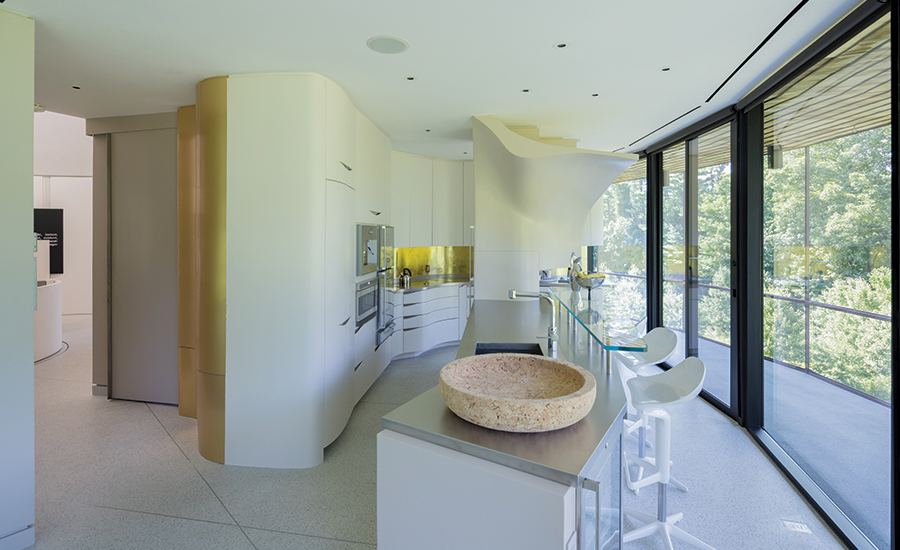
Image courtesy of Architectural Record
A big part of the renovation was to bring the home up to code and remove visual obstructions. A glass railing was designed and single-pane windows were replaced with double insulated glazing. The weathering-steel fascia was restored and replaced, and the home received new upgraded cedar shingles.
Scogin and Elam worked with plans found in Foster’s archives to ensure the original specialist for the cobblestone, first completed with the help of Foster’s three sons in 1968, could redo the entire outdoor terrace.
As the home was renovated, the new owners removed partitions to create a larger master bedroom suite and a larger bedroom for their daughter. A wall was also eliminated to help unify the living areas with the kitchen, as a more open concept living is preferred today.
Darrel Morrison, a renowned landscape designer was hired in 2014 to redevelop the entire four-acre property. The goal was to add balance, achieved by reintroducing many of the wildflowers, trees, stones, native cactus, and tall grasses that were once a part of the landscape.
A famous house still inspiring awe today, the Spaceship House, Round House, or however you’d like to call it, has been visited by many. In fact, it’s not uncommon for people to pull into the driveway to gawk at the home, although the home is not officially open for tours. Gawking strangers may not be a huge issue, however, as the current owners can simply press a button and turn away from any visitors when they don’t feel like waving or being watched.
